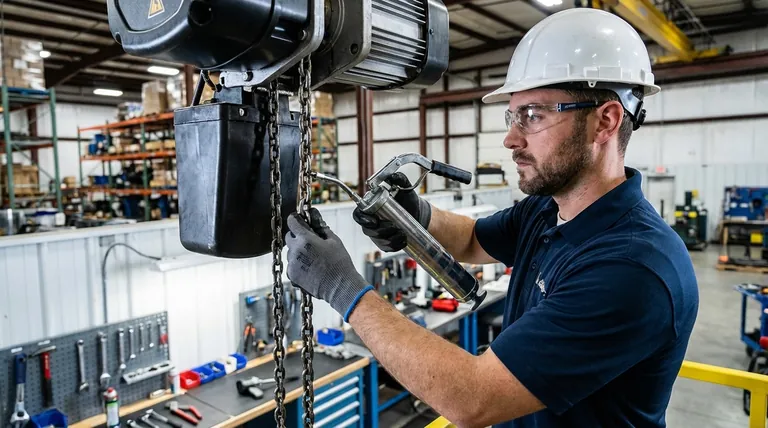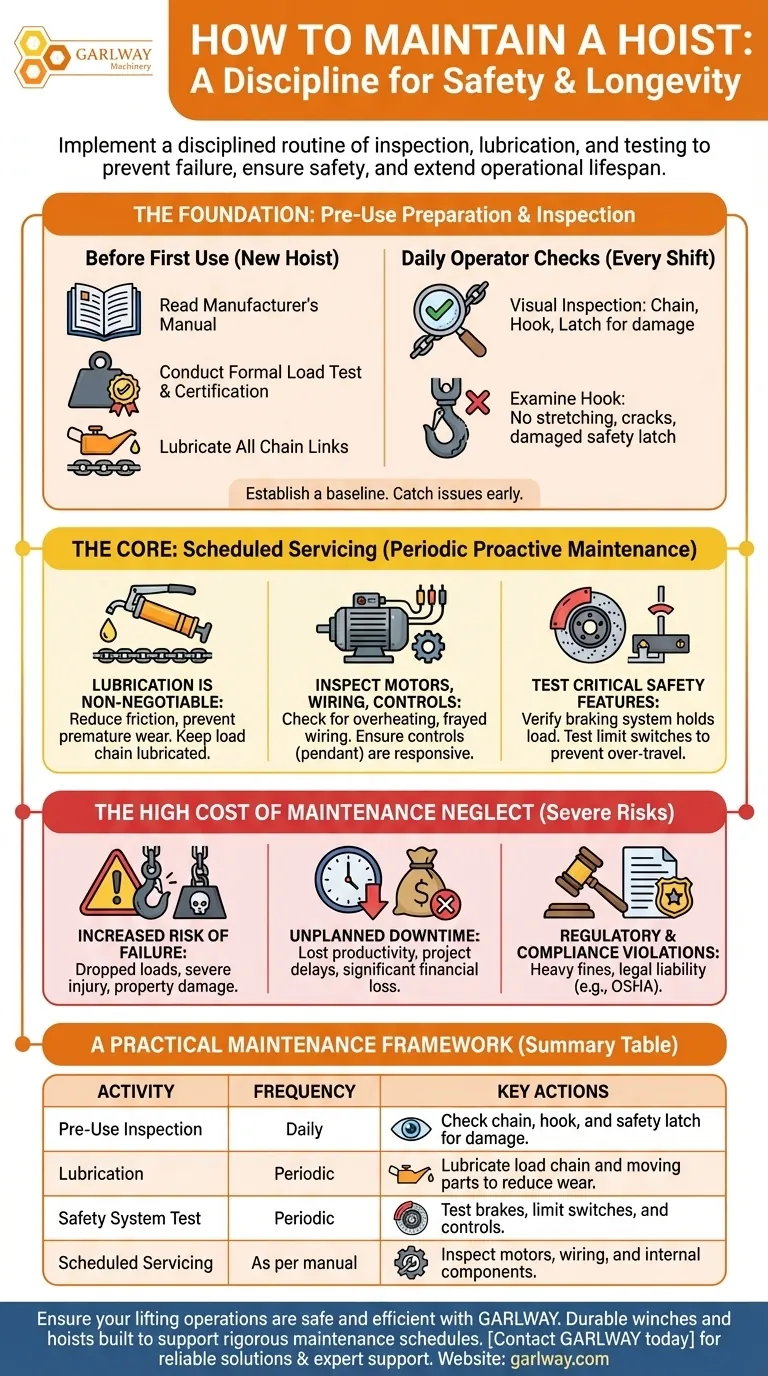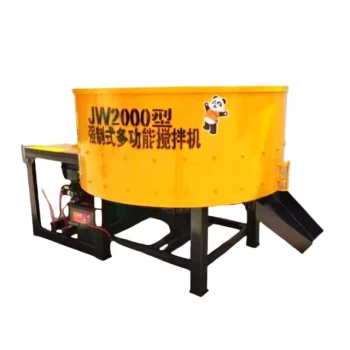To properly maintain a hoist, you must implement a disciplined routine of inspection, lubrication, and testing. This process involves daily pre-use checks for visible damage, periodic servicing of internal components like motors and brakes, consistent lubrication of moving parts such as the chain, and regular testing of all safety features.
Hoist maintenance is not merely about repair; it is a critical safety discipline. A consistent program of pre-use checks and scheduled servicing is the only reliable way to prevent equipment failure, ensure operator safety, and extend the hoist's operational lifespan.

The Foundation: Pre-Use Preparation and Inspection
Before a hoist ever lifts its first load, and before every shift it works, a foundational check is required. This establishes a baseline for performance and catches obvious issues before they become critical failures.
Before First Use
A brand-new hoist must be commissioned correctly. This is a non-negotiable step for safety and compliance.
First, read the manufacturer's manual thoroughly to understand its specific operational limits and maintenance requirements.
Next, ensure a formal load test is conducted and the hoist is properly certified for use according to local regulations.
Finally, lubricate all chain links as specified by the manufacturer to ensure smooth operation from the very beginning.
Daily Operator Checks
The operator is the first line of defense in identifying potential problems.
Before each shift, conduct a visual inspection of the hoist and chain. Look for any signs of wear, nicks, gouges, or twisted links.
Examine the hook for any signs of stretching, cracks, or a damaged safety latch. Any deformity requires the hoist to be removed from service immediately.
The Core of Maintenance: Scheduled Servicing
While daily checks catch surface-level issues, periodic servicing addresses the wear and tear on the hoist's internal systems. This is proactive, preventative maintenance designed to keep the hoist running reliably.
Lubrication is Non-Negotiable
Proper lubrication is one of the most effective ways to extend the life of a hoist.
Moving parts, especially the load chain, require regular lubrication to reduce friction and prevent premature wear. A dry or gritty chain is a clear sign of inadequate maintenance.
Inspecting Motors, Wiring, and Controls
The hoist's power and control systems must be inspected by a qualified technician.
This includes checking motors for signs of overheating or unusual noise, inspecting wiring for fraying or loose connections, and ensuring all controls (like the pendant) are responsive and function correctly.
Testing Critical Safety Features
Safety systems are your final safeguard against a catastrophic event. They must be tested methodically.
Regularly test the functionality of limit switches, which prevent over-travel of the hook.
Crucially, you must verify the hoist's braking system. The brake should engage immediately and hold a load securely without any slippage.
The High Cost of Maintenance Neglect
Ignoring a structured maintenance plan introduces severe risks that go far beyond the cost of a simple repair. It's a trade-off that is never worth making.
Increased Risk of Failure
A poorly maintained hoist is an unpredictable machine. Components like brakes or chains can fail under load, leading to dropped loads, property damage, and severe injury or death.
Unplanned Downtime and Lost Productivity
Equipment failure always leads to unplanned downtime. This halts operations, causes project delays, and results in significant financial losses that dwarf the cost of a preventative maintenance program.
Regulatory and Compliance Violations
Most jurisdictions have strict safety regulations (like OSHA in the United States) governing the use and maintenance of lifting equipment. Failure to maintain and document service can lead to heavy fines and legal liability in the event of an accident.
A Practical Maintenance Framework
Use this framework to structure your hoist maintenance activities based on their frequency and purpose.
- If you are putting a new hoist into service: Your priority is to read the manual, ensure it passes a certified load test, and lubricate the chain before its first use.
- If you are an operator starting a shift: Your primary focus is a quick pre-use inspection of the chain and hook for visible damage and testing basic functions before lifting.
- If you are responsible for periodic maintenance: Your goal is a thorough service, including lubricating all moving parts and testing critical safety features like the brakes and limit switches.
A structured maintenance routine transforms your hoist from a potential liability into a safe and reliable asset.
Summary Table:
| Maintenance Activity | Frequency | Key Actions |
|---|---|---|
| Pre-Use Inspection | Daily | Check chain, hook, and safety latch for damage. |
| Lubrication | Periodic | Lubricate load chain and moving parts to reduce wear. |
| Safety System Test | Periodic | Test brakes, limit switches, and controls. |
| Scheduled Servicing | As per manual | Inspect motors, wiring, and internal components. |
Ensure your lifting operations are safe and efficient with GARLWAY.
As a specialist in construction machinery, we provide durable winches and hoists designed for the demanding needs of construction companies and contractors globally. Proper maintenance is key to safety and productivity, and our equipment is built to support your rigorous maintenance schedules.
Contact GARLWAY today for reliable hoist solutions and expert support to keep your projects moving safely.
Visual Guide

Related Products
- Portable Cement Mixer with Lift Concrete Machine
- Ready Mixer Machine for Construction Ready Mix Machinery
- Small Electric Winch 120V and 240V for Compact Applications
- Commercial Construction Mixer Machine for Soil Cement Mixing Concrete
- Auto Concrete Cement Mixer Machine New
People Also Ask
- How do self-loading concrete mixers contribute to cost savings? Streamline Your On-Site Concrete Production
- In what types of construction projects are self-loading concrete mixers particularly useful? Boost Efficiency in Remote & Tight Sites
- What advantages do self-loading concrete mixers offer in terms of concrete quality? Achieve Superior On-Site Control
- What are the benefits of proper operation and maintenance of a self-loading concrete mixer? Boost Efficiency & Extend Lifespan
- How should the engine of a self-loading concrete mixer be started? Ensure Safe & Efficient Operation










